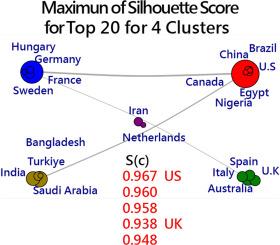廓形escoreinr:通过利用局部凝聚力和最近邻分离,超越传统的网络布局
IF 1.9
Q2 MULTIDISCIPLINARY SCIENCES
引用次数: 0
摘要
剪影分数(SS)通过对比聚类内凝聚力与最近的其他聚类分离来量化每个实体适合其指定聚类的程度。虽然SS在其他领域很常见,但在文献计量学中很少使用。使用2252篇MethodsX文章(2020-2024),我们展示了SS如何独立于所选算法评估共词网络和作者合作中的聚类质量。我们提供了R脚本来计算显式(地理/已知坐标)和隐式(PCA/UMAP)布局的SS,并引入了两轴可视化,根据SS绘制出版计数。该框架突出显示了一致的集群(高SS),并标记了标准网络图可能模糊的边界或分配不当的实体(低/负SS)。这提高了术语、聚类和语料库级别的可解释性,并支持关于标签、成员关系和后续分析的更具防御性的决策。代码的发布是为了复制和重用;讨论了对距离度量和数据制度的敏感性,以指导跨文献计量学和相关领域的应用。•廓形分数揭示异常值:廓形分数不仅验证了集群内聚性,还揭示了有意义的异常值,这是传统网络布局中经常遗漏的见解。•新颖的可视化方法:将剪影分数与出版物计数相结合,可以更细致地可视化合著词和协作网络。•应用于文献计量学:本研究将剪影分析应用于2252篇MethodsX论文,为评价文献计量学研究中的聚类质量提供了新的工具。本文章由计算机程序翻译,如有差异,请以英文原文为准。

SilhouetteScoreinR: Beyond traditional network layouts by leveraging local cohesion and nearest neighbor separation
The silhouette score (SS) quantifies how well each entity fits its assigned cluster by contrasting within‐cluster cohesion with nearest other–cluster separation. Although common in other fields, SS is rarely used in bibliometrics. Using 2,252 MethodsX articles (2020–2024), we show how SS evaluates clustering quality in co-word networks and author collaborations, independent of the chosen algorithm. We provide R scripts to compute SS for explicit (geographic/known coordinates) and implicit (PCA/UMAP) layouts and introduce a two-axis visualization that plots publication count against SS. The framework highlights coherent clusters (high SS) and flags boundary or misassigned entities (low/negative SS) that standard network plots can obscure. This improves interpretability at term, cluster, and corpus levels and supports more defensible decisions about labels, membership, and follow-up analysis. Code is released for replication and reuse; sensitivity to distance metrics and data regimes is discussed to guide application across bibliometrics and related domains.
- •Silhouette Scores Reveal Outliers: Silhouette scores not only validate cluster cohesion but also uncover meaningful outliers—insights often missed in traditional network layouts.
- •Novel Visualization Approach: Combining silhouette scores with publication counts enables a more nuanced visualization of co-word and collaboration networks.
- •Applied to Bibliometrics: This study applies silhouette analysis to 2252 MethodsX articles, offering new tools for evaluating clustering quality in bibliometric research.
求助全文
通过发布文献求助,成功后即可免费获取论文全文。
去求助
来源期刊

MethodsX
Health Professions-Medical Laboratory Technology
CiteScore
3.60
自引率
5.30%
发文量
314
审稿时长
7 weeks
期刊介绍:
 求助内容:
求助内容: 应助结果提醒方式:
应助结果提醒方式:


